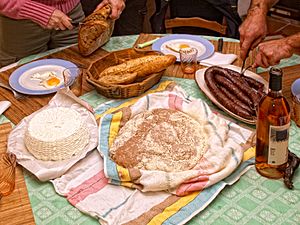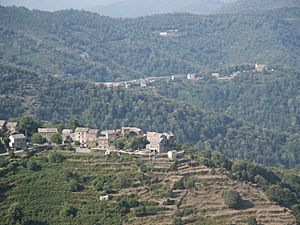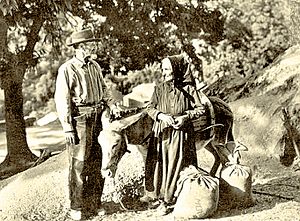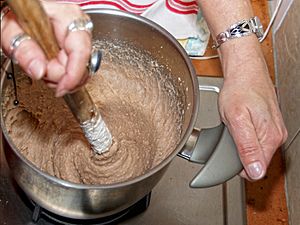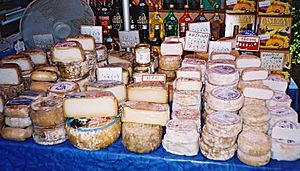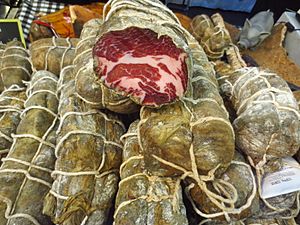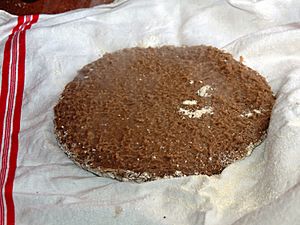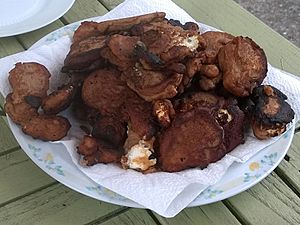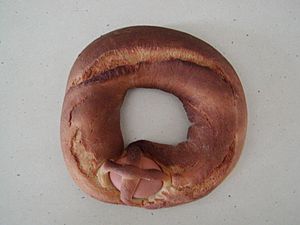Cuisine of Corsica facts for kids
The cuisine of Corsica is the traditional food of the island of Corsica. It uses many local ingredients. Because of Corsica's past and geography, its food is very similar to Italian cuisine. It also shares some similarities with the food of Nice and Provence.
Contents
A Taste of History: How Corsican Food Evolved
Corsica's shape, with its flat eastern coast, made it hard to defend. This area also had malaria, a disease spread by mosquitoes. Because of this, people chose to live in the mountains. In ancient times, Corsica exported sheep, honey, wax, and tar from its forests. The island was also known for its affordable wines.
Living in the mountains was common until the early 1900s. Many people lived high up, between 700 and 1,000 meters above sea level.
In the Middle Ages, around the 1100s, Pisa ruled Corsica. Many people from nearby Tuscany in Italy moved to the island. They brought their language, customs, and food. Later, when Genoa took over, people's eating habits changed a lot. In 1548, the Genoese governor ordered everyone to plant at least one chestnut, mulberry, olive, and fig tree each year. This was to help people find food.
Other rules followed, like one in 1619 that said 10 chestnut trees had to be planted yearly. Over time, this completely changed the look of many parts of the island. Chestnut trees replaced most other crops. One area, Castagniccia, even got its name from its many chestnut (castagnu) forests.
By the 1700s, chestnuts had almost completely replaced grains. Chestnut trees saved islanders from frequent famines. A historian wrote that in the 1730s, travelers carried wine and chestnut bread or roasted chestnuts. An old Corsican saying from Niolo means "Wooden bread and stony wine." This shows how important chestnuts were and how simple the mountain people's food was.
Before France took over, Pasquale Paoli, a Corsican leader, tried to get people to grow potatoes. His opponents made fun of him, calling him "The General of Potatoes."
When France took control in 1768, things changed. The French army cut down many chestnut forests to control rebels. This continued even after peace, as Paris preferred grains over chestnuts. However, the cutting stopped later. Until the early 1900s, chestnuts (as pancakes, bread, or porridge) remained the main food for most Corsicans.
By the late 1700s, Corsicans also ate grains (wheat and rye), dried vegetables, and cured meats. Some exceptions existed. For example, in 1775, rich vineyard owners in Cap Corse bought Italian pasta, goat meat, pork, and cod with their wine money. Poor people in the same area ate wild herb soups in winter.
Most Corsican food in the late 1700s was plant-based. The mayor of Stazzona said chestnuts were the main food, prepared in 12 different ways. From November to June, only chestnut bread was eaten. Villagers also grew their own vegetables. Trout and eels added variety to this simple diet.
After the 1900s, the old village economy, based on chestnuts and local pork, began to disappear. After World War II, malaria was wiped out. This allowed people to live on the east coast, and many moved away from the mountains.
These changes led to less traditional food production. In 1796, chestnuts covered 35,442 hectares. By 1977, they still covered 25,000 hectares, but only 3,067 hectares were farmed. The rest were left for animals. Today, demand from tourists and new quality standards (like AOC and AOP labels) are helping to bring back some traditional food production.
Special Corsican Foods
Chestnut: The Island's Staple
The chestnut tree was widely planted in Corsica during Genoese rule. Chestnuts are rich in calories. They were picked, dried, and smoked over a fire for a month. This fire also smoked cured meats and heated homes. After drying, they were ground into chestnut flour, which got a smoky flavor. Pigs that roam the forests eat unpicked chestnuts. They are also fed chestnut flour, which gives their meat a special taste.
Chestnut flour was the main ingredient for `pulenta` (a type of polenta) and cakes. Chestnuts were so important that at a wedding in the 1800s, 22 different dishes were made with them!
Today, Corsican chestnut flour has special quality labels: French AOC and European AOP. It is called Farine de châtaigne corse-Farina castagnina corsa. Most chestnuts picked in Corsica are turned into flour. This flour is mostly eaten on the island, with a small amount sent to mainland France for Corsicans living there.
Chestnuts are celebrated at two yearly fairs: A Fiera di a Castagna in Bocognano in early December, and the Fête du Marron in Évisa in late November.
Cheese: From Sheep and Goats
Traditional Corsican cheeses are made only from sheep or goat milk. The most important cheese is Brocciu. It's a whey cheese similar to ricotta, but without lactose. It's mostly made from sheep milk, sometimes goat milk. You can eat Brocciu fresh or aged. It's used in many Corsican dishes, from main courses to desserts. Brocciu is the only Corsican cheese with the special AOC label.
Other notable cheeses include niulincu (from Niolo), balaninu (from Balagne), bastilicacciu and sartinesu (from Bastelica and Sartène), and cuscionu (from Zicavo valley). There's also casgiu merzu, a "rotten cheese" with insect larvae, like the Sardinian casu marzu. Corsican cheese makers meet every year in early May at the cheese fair (A Fiera di U Casgiu) in Venaco.
Charcuterie: Cured Meats
Corsican charcuterie (cured meats) is known for its quality. This is because of traditional methods and the special Corsican pigs (porcu nustrale). These pigs live partly in the wild and are fed chestnuts and chestnut flour. Each farming family usually raises one or two pigs. They are typically slaughtered in December, around 14 months old. The whole pig is used to make different products.
On slaughter day, dishes like `figatelli` (liver sausage), `boudin` (blood sausage), and `ventra` (similar to Italian `sanguinaccio`) are made. Pigs are raised in the mountains, where they can roam freely. A pigherd (u purcaghju) watches them. They search for chestnuts, roots, and small animals in the woods. In the evening, they are fed kitchen scraps and spoiled apples.
Popular cured meats include prisuttu (ham), panzetta (bacon), lonzu (pork fillet), figatellu (pork liver sausage), and capicollu (also called coppa). `Figatellu` is smoked for a few days, then dried. It can be eaten roasted or grilled. `Prisuttu`, `coppa`, and `lonzu` received the AOC quality label in 2012.
Corsicans also make various pâtés (pastizzi). These include pâtés from pork liver, thrush, hare, and wild boar.
Olive Oil: Liquid Gold
Corsican olive oil is mostly made in the hills of Balagne, in the northwest. About a quarter of all olive trees on the island are there. Another important area is Alta Rocca, near Bonifacio. In Santa Lucia di Tallano, they celebrate the Festa di l'olio novu each year for the new oil.
Overall, Corsica has 2,000 hectares of olive groves, farmed by 300 producers. The olives are mostly black. They are not picked by hand; they fall onto nets under old trees. Olives on younger trees are picked by machine. The harvest happens when they are ripe, from November to May. Since 2004, Corsican oil has been an AOC product, called Huile d'Olive de Corse-Oliu di Corsica. It also has the European AOP label.
Olive trees in Corsica face a threat from Xylella fastidiosa, a disease spread by tiny insects. This disease was reported to have spread from Italy in 2018.
Delicious Corsican Dishes
Soups: Warm and Hearty
Soups (minestre) are a big part of Corsican cooking. The minestra, or zuppa corsa, is like the Italian minestrone. It's a soup with beans, potatoes, garlic, onion, mangelwurzel, cabbage, and tomatoes. A ham bone and shortening give it richness. Other traditional soups include bread soup (minestra di pane cotto), and soups with fresh or aged `brocciu`. There are also soups with red beans and leek. On Maundy Thursday, chickpeas replace meat in the minestra incu i ceci di Iovi Santu. `Stufatu` is a soup made with wheat or corn flour. `Brilluli` is a porridge of chestnut flour, water, and goat milk.
Pasta, Gnocchi, and Polenta: Italian Influence
Pasta dishes clearly show Italy's influence on Corsican food. Stuffed pasta like ravioli and cannelloni are popular. Both are filled with `brocciu`, often with spinach. Pasta sauce with tomatoes and minced meat is also common.
Other dishes also reflect Italian traditions:
- sturzaprezi are large gnocchi baked in an oven, made with `brocciu` and spinach.
- Panizzi are fritters made with gram flour, similar to Sicilian `panelle`.
- Lasagne and gnocchi with meat sauce are also popular.
While corn polenta is known, in Corsica, `Pulenta` usually means `pulenta castagnina`, made with chestnut flour. Another chestnut flour dish is `Maccaredda`, fritters fried with `panzetta` (bacon). `Razighe` are thin pancakes from Rusio, made with wheat flour, yeast, egg, and cracklings. Migliacci are savory galettes made from wheat flour, yeast, whey, and goat and sheep cheese, baked on chestnut leaves.
Meat: From the Maquis
Corsican meat is very flavorful because animals eat the many herbs of the maquis (machja). Lamb (agnellu) and kid (caprettu) are very popular, especially at Easter. They can be roasted, made into a ragout (tianu), or a stew (in cazzarola). `Stufatu` is a stew with beef, ham, garlic, onion, clove, and herbs.
Game meat is also common: wild boar (singhjari), thrush (tordulu), hare (levru), and snipes (bicazzi) all have their own recipes. Several dishes are made when a pig is slaughtered:
- `Sanghi di maiale incu l'uva secca` is a blood sausage with raisins.
- `Ventra` is another dish with pork blood, pork stomach, and mangold.
- `Casgiu di Porcu` ("Pork cheese") is made by boiling pork head and feet, then cooking the meat with spices and letting it harden.
- `Misgiscia` is a goat fillet, cut into thin slices, soaked in vinegar, spiced, and skewered on a branch. It's dried in the sun and eaten grilled or as a ragout.
- `U sdruttu` is clarified pork fat, used instead of olive oil.
Porto Vecchio is known for three dishes made with innards:
- `Corda`: goat or sheep intestines boiled and cooked with onion and garlic.
- `Rivia`: lamb or kid intestines cooked on a skewer, wrapped in the animal's caul, and pickled.
- `Manghjaria`: ram, sheep, or goat tripe, once offered at funerals.
Fish: From Sea and River
About 40 types of fish are caught in the sea around Corsica. Fish are also plentiful in the island's rivers and creeks. Fish soup is typical, either with sea fish (azziminu di Capicorsu) or river fish (azziminu di Corte).
Dishes with baccala and stockfish are a legacy from Genoese times. `Baccala` can be deep-fried (fritelle di baccalà). A recipe from Bonifacio uses `baccala` with mangold and raisins. `Stockfish` is prepared with tomatoes, anchovies, and walnuts in a dish called u pestu.
`Brocciu` cheese is also used with fish. Examples include sardines stuffed with `brocciu` (sardine piene incu u brocciu) and anchovy-brocciu cake (torta d'anchjuve e di brocciu).
The large lagoons on the east coast, like the Étang de Biguglia and de Diana, provide eels. These are cooked roasted (anguilla arustita) or as a stew (tianu d'anguila). Mountain creeks have many trouts. They are eaten stuffed with `brocciu` (truite piene incu u brocciu) or simply roasted over a hot river stone.
Vegetables: Stuffed and Savory
Corsican cuisine, like other Mediterranean foods, features many stuffed vegetables (ripieni). The stuffing always includes `brocciu`. Examples are stuffed artichokes (l'artichjocchi pieni), zucchini (e zucchine piene incu u brocciu), aubergines (from Porto Vecchio and Sartène) (i mirizani pieni), and onions (e civolle piene incu u brocciu).
Vegetarian ragouts are also popular. These include ragout with fava beans (u tianu di fave fresche) or with red beans and leeks (u tianu di fasgioli e porri). `Sciacci` are short pastry fritters filled with potatoes (sciacci di pommi) and grated cheese.
Desserts: Sweet Treats
Chestnut flour and `brocciu` are common in many Corsican cakes.
- Falculelle from Corte are small cakes made with `brocciu`, sugar, flour, and egg yolk. They are baked on a chestnut leaf.
- Cacavellu from Vico is a round cake with a dough of wheat, yeast, eggs, and `sdruttu`. It's filled with `brocciu` mixed with sugar, orange zest, and eggs.
- Fiadone is a cheesecake made with `brocciu`, eggs, sugar, and citron zest.
- Imbrucciate are small `fiadoni` with a puff pastry base.
- Canistrelli, similar to Italian `Canestrelli`, are biscuits made with flour, butter, sugar, and flavored with white wine or anisette.
- Cucciole from Balagne are biscuits made of flour, oil, sugar, and white wine.
- Castagnacciu is a simple cake with chestnut flour, raisins, and walnuts.
- nicci are chestnut flour galettes cooked in the fireplace between two iron plates.
- Frappe are fried dough shapes flavored with lemon zest, similar to Italian `castagnole`.
Many cakes are made for holidays and special events:
- Strenna (a pie with `brocciu` filling) is made in Vico for New Year's Day.
- Panzarotti (beignets made with flour, rice, and yeast) are made in Bastia for St. Joseph's Day (March 19).
- Panette are for All Saints' Day (November 1).
- Pan di i morti (small breads with flour, yeast, sugar, butter, eggs, raisins, and walnuts) are for All Souls' Day (November 2) in Bonifacio.
- canestri (donuts) and campanili (donuts with boiled eggs) are for Easter.
- Sciacci (sweet fritters with `brocciu`, cooked on a hot granite stone) are made in Sartène at Easter and during sheep shearing in May.
- Inuliata, made in Ajaccio during Holy Week, is a yeast cake with flour, powdered sugar, olive oil, and wine.
- Fritelli, eaten on Maundy Thursday in Calenzana, are wheat or chestnut flour fritters.
Corsicans also make many fruit preserves (confiture) at home. These use local fruits like chestnut (confitura di castagne), fig (confitura di fichi), red tomatoes (confitura di pummata rossi), and strawberry tree (confitura d`arbitru). A special treat is citron confit (confit d'alimea), made from fruits grown in the Cap Corse region.


